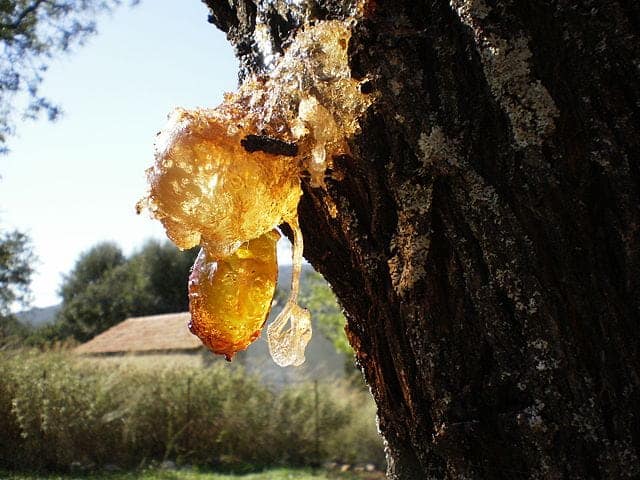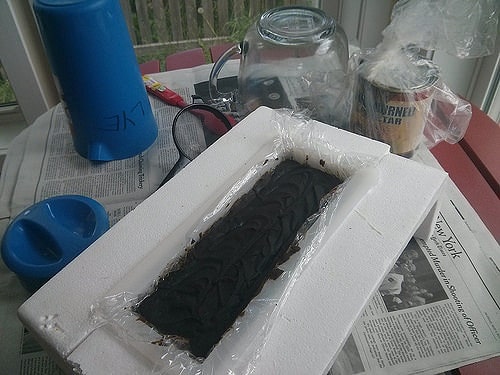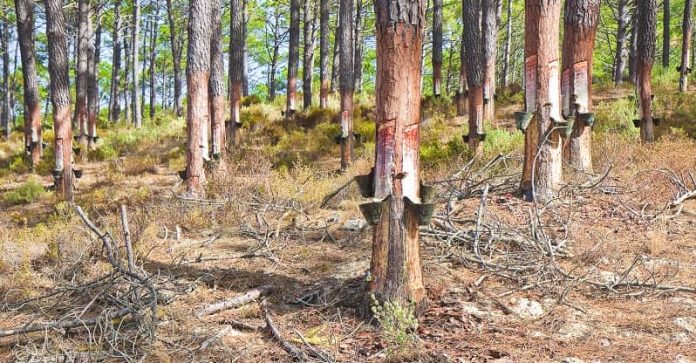Pine tree sap holds a treasure trove of uses that our ancestors knew well.
From traditional remedies to practical solutions, let’s rediscover the forgotten wisdom of using pine tree sap.
1. Pine Sap Salve

Pine trees ooze resin when they get damaged. The resin has antibacterial properties, which prevent the damaged tree from getting infected.
In this same way, pine resin can also heal our wounds.
In addition to being a natural antiseptic, pine sap is anti-inflammatory, and its stickiness helps close wounds. It also works well for healing eczema.
Follow these instructions to make pine pitch salve:
- Collect sap from pine trees
- Using a double boiler, heat the sap into a liquid. Do not heat the pine sap directly over a flame because it is highly flammable!
- Strain the heated pine sap through a sieve to remove dirt or bark
- Mix the pine sap with olive oil over a double boiler
- Add some beeswax to make it firm.
2. Pine Sap Lamp
Pine resin is flammable. This makes it great for making primitive lamps.
Note: you can NOT make a candle out of pine resin (even though many websites say you can). Even if you mix the pine resin (or pitch) with beeswax when making the candle, the pine resin will just ignite into a big ball of flames – not a slow-burning candle with a small flame at the wick.
What you can do is make a “lamp” from pine sap or pitch. Here’s how.
- You’ll need a rock in a bowl shape and a bit of moss.
- Put some moss in the bowl to act as a wick.
- Surround the moss with some pine resin.
- Light the moss. Now you’ve got a lamp.
- Add more pine resin as it burns out.
Alternatively, you can hollow out a piece of wood and stuff it full of pine resin or pine pitch and a little fabric to act as the wick. Then light it, and it will burn for a while, kind of light a primitive tea light.
Here’s a video of how to make a pine sap “candle.”
3. Pine Pitch Glue
Pine pitch works great as glue because it is strong, sticky, and waterproof. First, you have to make your pine pitch. The only problem is that pine pitch hardens when it dries. You’ll have to heat it to use it – which can be messy. The best solution for this is to put your pine pitch on the end of a stick.
After making your pine pitch while it is still liquid, swirl a stick in it. Then, set the sticks aside to dry. When it is time to use the pitch glue, use a fire to heat the pitch on the stick. The pitch will drip off onto whatever you want to glue.
It is kind of like a primitive hot glue stick.
4. Pine Pitch Torch
Get yourself a long stick to use as the base of your torch. Next, you will need some long, thin fabric or cotton rope scraps. Wrap the fabric or rope around the top of your stick. Make some pine pitch. Dip the fabric/rope into the pitch and let it dry. Light it up, and you have a torch that will burn for a reasonably long time.
*If you don’t feel like making pine pitch, use melted pine resin instead.
Alternatively, you can get a long, thick stick. Using a saw, cut some notches into one end of the stick. You can fill the notches with pine sap or pine pitch. Then just light it on fire.
Note that the pine pitch will drip down the torch and be HOT. Do not hold onto this torch; plant it into the ground instead.
Read more about making a torch in the woods.
5. Pine Tar Soap

Pine tar soap has been used for a long time but fell out of popularity once chemical soaps became available. Because of pine’s natural antiseptic qualities, it is a great soap. You will have to make pine tar before you can make soap. You can also use pine pitch.
Here is a video of the process.
6. Pine Pitch for Waterproofing
In my opinion, this is by far the best survival use for pine pitch. Pine pitch is not water-soluble, and it is incredibly durable. You can waterproof all sorts of things, such as using it in the seams of your survival boots.
Traditionally, pine pitch was used to waterproof boats and buckets. Even Noah used pitch to waterproof the Ark!
To apply pine pitch, you’ll need to heat it first (use a double boiler so it doesn’t catch on fire!). Then just paint it on whatever you need to waterproof.
Note that you don’t want to use pine pitch for waterproofing things that will be in high heat. The pine pitch will just melt off! It also gets brittle in cold weather, so you’ll probably have to reapply each season.
Have you used sap for anything? Do you think these traditional methods are worth preserving?
Related
Pine trees are a fantastic resource, and most parts of the tree are edible.
See these articles for more:








